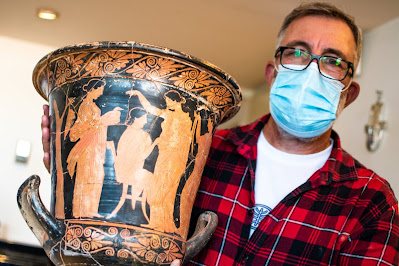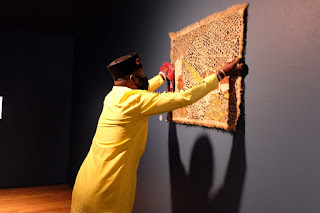 Cambodia,Cambodian art,Christie's,Dirk Obbink,Douglas Latchford,Egypt,ethical collecting,Ghassan Rihani,green collection,Hobby Lobby,HSI,illicit antiquities,Iraq,Museum of the Bible,Oxyrhynchus Papyri
Cambodia,Cambodian art,Christie's,Dirk Obbink,Douglas Latchford,Egypt,ethical collecting,Ghassan Rihani,green collection,Hobby Lobby,HSI,illicit antiquities,Iraq,Museum of the Bible,Oxyrhynchus Papyri
 1 comment
1 comment
Sometimes restitution is a little like putting lipstick on a pig
Last week we have seen two eye-popping notices of "voluntary" restitution of ancient artefacts and papyri framents believed to have been plundered from their respective countries of origin.
In one instance, an article by Tom Mashberg, written for the New York Times on January 29th reported that Julia Ellen Latchford Copleston a/k/a Nawapan Kriangsak, has agreed to relinquish a total of 125 artefacts to Cambodia which had been acquired by her father, controversial antiquities dealer Douglas A.J. Latchford, a/k/a “Pakpong Kriangsak.” Prior to his death, Latchford's handling of suspect material from Cambodia, Thailand and India resulted in the US government filing a 26-page indictment via the Department of Justice's U.S. Attorney’s Office for the Southern District of New York on 27 November 2019. This case, unfortunately, concluded in advance of any possible legal ruling against the Thailand-based dealer, who died on 2 August 2020 before the bulk of the evidence gathered in the federal case against him could be heard in court.
The second announcement, delivered two days earlier by Steve Green, Chairman of the Museum of the Bible, was more discreetly posted on the museum's website and highlighted the return of a number of questionable acquisitions which have been discussed with some regularity on ARCA's blog as well as in greater detail on Faces & Voices, a specialist blog by Papyrologist and ancient historian Roberta Mazza. Mazza has more articles about the Green's acquisitions than I can link to, so I recommend our readership take some time exploring them all but perhaps starting here with one where she questions (again) the ever-changing provenance story surrounding the P.Sapph.Obbink fragment purportedly sold through a private sale treaty by Christie’s.
In Green's press announcement, he states that as of 7 January 2021, the Washington DC-based museum had transferred control of the fine art storage facility that housed the 5,000 Egyptian items to the U.S. government as part of "a voluntary administrative process." Unfortunately, the philanthropic founder of the museum has said very little about whether or not his museum will be more forthcoming about exactly whom the museum paid when purchasing the 8,106 clay objects with suspect or no provenance from the Republic of Iraq or the approximately 5,000 papyri fragments and accompanying mummy cartonnage which also came with suspect or no provenance from the Arab Republic of Egypt. All we know is that these objects are now, finally, going home. And while that is a great success for the countries they were taken from, it tells us practically nil about the men who engaged in their sale and profited from these same countries' exploitation.
At the end of their announcement, the Museum of the Bible's Chairman stated that going forward they would continue to look for ways to "partner with The Iraq Museum, The Coptic Museum, and other institutions, to provide assistance with preserving and celebrating the rich cultural histories of those countries and many others." I truly doubt, given the circumstances, that the Egyptian government will be taking Mr. Green up on this proposal.
 |
| Museum of the Bible Press Release Screenshot Date:27 January 2021 |
And so the litigation in these matters, at least as it relates to Iraq and Egypt, appear to be drawing to a close.
With the flourish of pens in the plump fingers of lawyers, these carefully-timed, and responsibility-for-wrong-doing-absent restitutions by members of the wealthy Houses of Latchford and Green are released to the public without the impediment of contradiction. Sanitised proclamations which imply good deeds done under trying circumstances, but which impart little about the actual motivations of their delayed generosity.
Most of us, who have been closely following these events can speculate as to the pressure points behind the disputants' seemingly magnanimous handovers and come away with our own conclusions, but our speculation will never give us their complete stories. It is reasonable to assume that these individuals, and/or their museum, were motivated, in whole or in part, by a desire to put an end to a publically embarrassing chapter to their respective family's cultural heritage acquisition histories, but their decisions should not be read as merely repentant.
In relinquishing these artefacts to Cambodia, Egypt and Iraq, the Latchfords and Greens seek to mitigate the damages, financial and reputational, that these scandals have caused them. And with that in mind, their decisions can not simply be seen in a vacuum of attempting to right past wrongs. They are assuredly more strategic than what is within the purview of the public domain.
Seen through this narrow lens, these very public announcements of voluntary restitution, published in newspapers with large readership or on museum's websites, serve only to cosmetically cover, not correct, the public blemishes their respective criminal investigations have brought to light over the last ten years. Actions which, when explored more deeply, can be seen as not only embarrassing, or ethically negligent, but potentially criminal, brought about by the direct involvement of staff and family members who should have, or definitely did know, better.
Despite these joyous restitutions, we cannot ascertain what catalyst, in each of these drawn-out processes of ensuring restorative justice, brought Mr Green and Ms. Copleston to the restitution table. Usually, in situations like this, written agreements between the parties make it unlikely that anyone will be at legal liberty to openly discuss the negotiations between the aggrieved parties. In the MotB case, that includes the unspoken details behind the more than three years of back and forth discussions that the museum itself has admitted took place prior to the culmination of this week's announcement.
Likewise, by bequeathing his 1,000-year-old Khmer Dynasty collection to his daughter, Douglas Latchford left his offspring with more than just $50 million worth of valuable ancient art. He left her holding a hand grenade with a pulled pin that she doggedly continued to hold some five months after her father's death. For no matter how magnanimous Copleston's repatriation gestures to Cambodia may seem in print, her waiting this long to relinquish the sculptures begs its own questions as to motivating factors.
Why would a lawyer such as herself, who by her own statement in the New York Times defensively admitted that her father "started his collection in a very different era" not have advised her ailing father, who was facing prosecution on his death bed, to clear the family name, if not his own, by simply returning the artefacts to Cambodia himself while he was still living? Or why, since Latchford's death, has Copleston, not distanced herself from suspicion by voluntarily doing so immediately after any wills for her father were read?
As regards both of these restitutions I would ask these individuals why, with these grand gestures of reconciliation, did neither party turn over the purchase and sale records for these objects. Something which would truly make reparations as doing so would allow illicit trafficking researchers and law enforcement investigators to trace and return other pieces of history handled by the individuals responsible for engaging in these two unseemly debacles.
Instead, like with Green's own statement, we get no real responsibility-taking, only precisely worded announcements with appealing attestations which colour their actions as generous acts of voluntary cultural diplomacy. This despite the fact that there is so much more they could do, aside from simply cutting their losses by relinquishing material.
In resignation, I understand that decisions like these, come about as the result of complex cultural arbitration. And I understand that in such circumstances, the party holding the stronger deck of cards in the dispute, might (still) agree to a more palatable dispute resolution outside the courtroom. One which allows the parties involved to avoid a lengthy, expensive, and in some cases, reputationally damaging legal case, but which also assures an alternatively beneficial outcome for all sides.
And as much as I want to be privy to these closed conversations, it is important to remind myself that Alternative Dispute Resolutions, known as ADRs in cultural property disputes, often carry with them an adherence to mutually agreed-upon confidentiality regarding the agreements signed off on, even when these types of agreements don't "feel" satisfying to those of us not sitting at the negotiating table.
As someone who works on the identification of illicit antiquities, I want to see individuals, believed to have behaved criminally, brought to justice. But I must also understand that these types of quieter negotiations do offer aggrieved parties an opportunity for a speedier and less costly resolution than drawn-out, complex, multi-year litigation which of themselves can be more beneficial to harvest countries such as Egypt and Iraq. Fighting for restitution in the US court system isn't cheap and the costs can be a financial impediment to some foreign governments who haven't the financial means to represent their interests for years on end, or when the application of legal norms to relevant facts, might fail to deliver any justice at all to them as the aggrieved party.
Another driving factor to remember in these types of agreements, in contrast to legal proceedings, is that out of court settlements enable the parties involved to, on the surface at least, legally protect their reputations. When cases go to court there is normally a winner and a loser. And with those court decisions, comes very public case records which can serve to outline, in embarrassing red marker detail, the actions of individuals perceived as culpable, or serve as precedent-setting decisions in future illicit trafficking court cases.
Lastly, as legislation in the art and cultural heritage field is not fully harmonized, there is always the potential risk that the expensive and protracted court case might not achieve a viable cost-benefit outcome. Like in legal disputes where the value of the returned artefact is less than the country's legal costs in pursuing the case in foreign courts. Or, as would have been the case in the Museum of the Bible dispute, or the case against Douglas Latchford, where the sheer number of artefacts being contested, if examined individually and concretised in the court's record, might have resulted in fewer objects going home, or greater exposure of the involved parties to subsequent litigation for their perceived roles in further uncovered, questionable transactions.
So, in the end, I have to accept announcements like those made last week which bring objects home but offer no real retribution against those who behaved badly. This leaves me, and others who have closely followed these cases, asking:
- Where are the admissions of fault?
- Where are the acknowledgements of harm having been done?
- Where are the answers we keep asking as to who sold what, to whom, and when?
“A hog in a silk waistcoat is still a hog.”
And while I am overjoyed that so many artefacts will finally make their way back to where they rightfully belong, I am in no way fooled that these gestures were magnanimous and selfless, or that in Egypt at least, Ma’at, the goddess of truth and justice, would believe that justice has been well and truly served.
By: Lynda Albertson
























